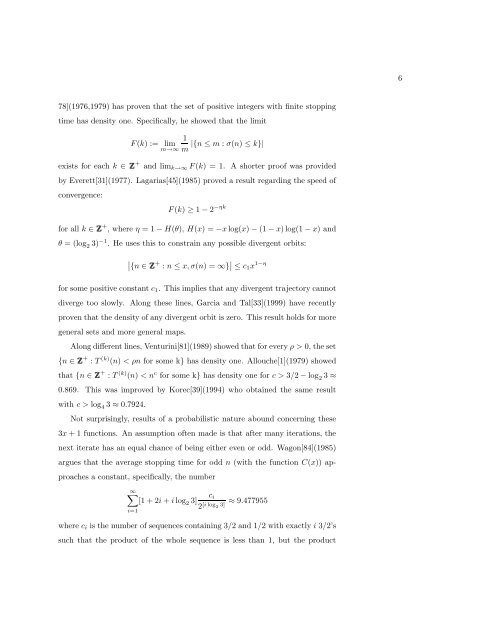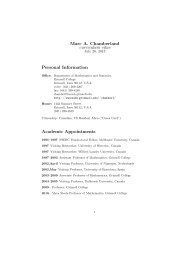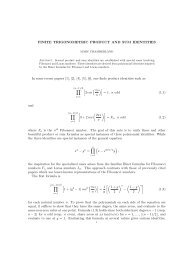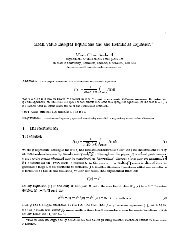An Update on the 3x+1 Problem Marc Chamberland Contents
An Update on the 3x+1 Problem Marc Chamberland Contents
An Update on the 3x+1 Problem Marc Chamberland Contents
Create successful ePaper yourself
Turn your PDF publications into a flip-book with our unique Google optimized e-Paper software.
6<br />
78](1976,1979) has proven that <strong>the</strong> set of positive integers with finite stopping<br />
time has density <strong>on</strong>e. Specifically, he showed that <strong>the</strong> limit<br />
1<br />
F (k) := lim |{n ≤ m : σ(n) ≤ k}|<br />
m→∞ m<br />
exists for each k ∈ Z + and lim k→∞ F (k) = 1. A shorter proof was provided<br />
by Everett[31](1977). Lagarias[45](1985) proved a result regarding <strong>the</strong> speed of<br />
c<strong>on</strong>vergence:<br />
F (k) ≥ 1 − 2 −ηk<br />
for all k ∈ Z + , where η = 1 − H(θ), H(x) = −x log(x) − (1 − x) log(1 − x) and<br />
θ = (log 2 3) −1 . He uses this to c<strong>on</strong>strain any possible divergent orbits:<br />
∣ {n ∈ Z + : n ≤ x, σ(n) = ∞} ∣ ∣ ≤ c1 x 1−η<br />
for some positive c<strong>on</strong>stant c 1 . This implies that any divergent trajectory cannot<br />
diverge too slowly. Al<strong>on</strong>g <strong>the</strong>se lines, Garcia and Tal[33](1999) have recently<br />
proven that <strong>the</strong> density of any divergent orbit is zero. This result holds for more<br />
general sets and more general maps.<br />
Al<strong>on</strong>g different lines, Venturini[81](1989) showed that for every ρ > 0, <strong>the</strong> set<br />
{n ∈ Z + : T (k) (n) < ρn for some k} has density <strong>on</strong>e. Allouche[1](1979) showed<br />
that {n ∈ Z + : T (k) (n) < n c for some k} has density <strong>on</strong>e for c > 3/2 − log 2 3 ≈<br />
0.869. This was improved by Korec[39](1994) who obtained <strong>the</strong> same result<br />
with c > log 4 3 ≈ 0.7924.<br />
Not surprisingly, results of a probabilistic nature abound c<strong>on</strong>cerning <strong>the</strong>se<br />
3x + 1 functi<strong>on</strong>s. <str<strong>on</strong>g>An</str<strong>on</strong>g> assumpti<strong>on</strong> often made is that after many iterati<strong>on</strong>s, <strong>the</strong><br />
next iterate has an equal chance of being ei<strong>the</strong>r even or odd. Wag<strong>on</strong>[84](1985)<br />
argues that <strong>the</strong> average stopping time for odd n (with <strong>the</strong> functi<strong>on</strong> C(x)) approaches<br />
a c<strong>on</strong>stant, specifically, <strong>the</strong> number<br />
∞∑<br />
[1 + 2i + i log 2 3]<br />
i=1<br />
c i<br />
2 [i log 2<br />
3]<br />
≈ 9.477955<br />
where c i is <strong>the</strong> number of sequences c<strong>on</strong>taining 3/2 and 1/2 with exactly i 3/2’s<br />
such that <strong>the</strong> product of <strong>the</strong> whole sequence is less than 1, but <strong>the</strong> product





